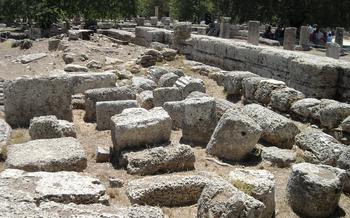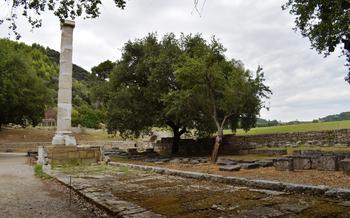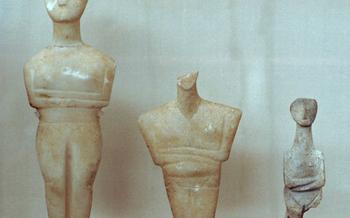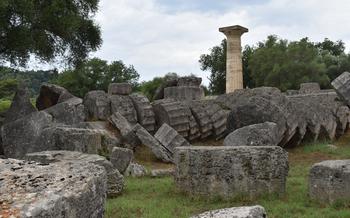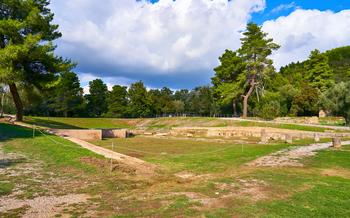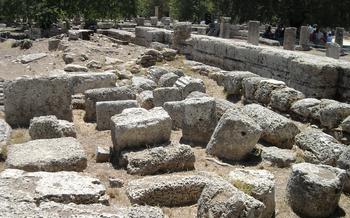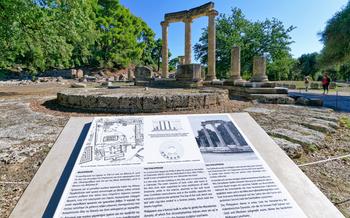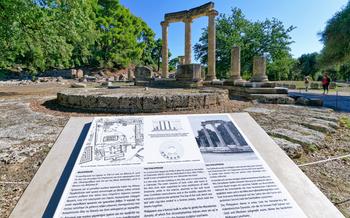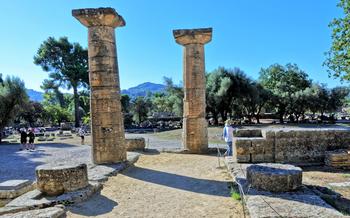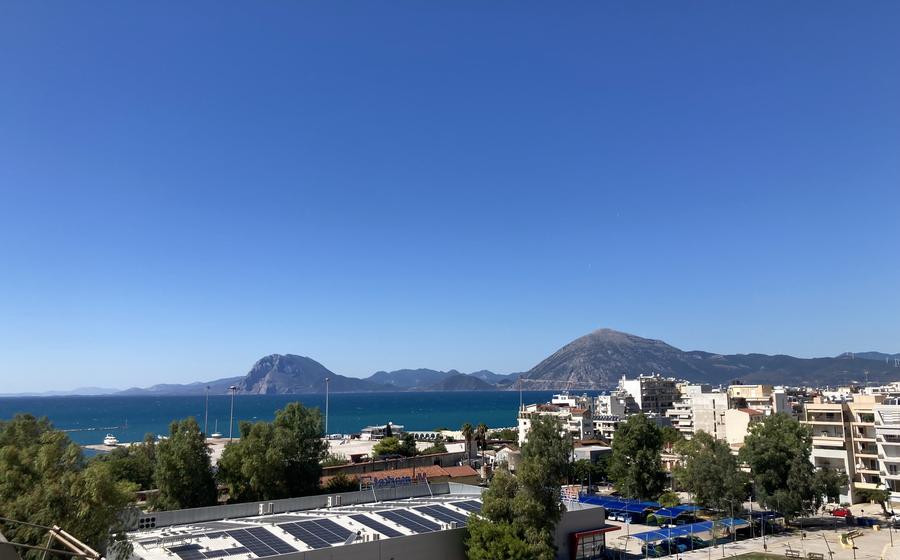
The Ancient Olympia Site
- Ancient Olympia: A Journey Through History and Legacy
- Temple of Zeus
- Heraion
- The Olympic Stadium: Arena of Ancient Athleticism
- The Treasuries
- The Philippeion
- The Museum of Ancient Olympia
- The Archaeological Site of Olympia Today
- Visiting the Ancient Olympia Site
- Accommodation and Dining
- Things to Do Nearby
- Local Festivals and Events
- Planning Your Trip
- Insider Tip: Unveiling Hidden Gems
Ancient Olympia: A Journey Through History and Legacy
Olympia, a name synonymous with athleticism, mythology, and cultural heritage, beckons travelers to embark on a journey through time. As the birthplace of the Olympic Games, this ancient city holds an unrivaled place in history. Its ruins, remarkably preserved amidst the Peloponnesian landscape, invite visitors to explore the origins of one of the most celebrated sporting events in the world.
Olympia's significance extends beyond the realm of sports. It was a sacred sanctuary dedicated to Zeus, the king of the gods, and a prominent site of religious worship in ancient Greece. The city's temples, altars, and votive offerings bear witness to the deep reverence and awe held by the ancients for their deities. In recognition of its exceptional cultural and historical value, Olympia has been designated as a UNESCO World Heritage Site, ensuring its preservation for generations to come.
Temple of Zeus
The Temple of Zeus, a magnificent testament to ancient Greek architecture, stands as a symbol of the god's power and majesty. Its colossal size, measuring approximately 64 meters in length and 27 meters in width, commands attention and evokes a sense of awe. Constructed from local limestone, the temple's imposing columns, each towering at over 10 meters, create a grand entrance that leads to the inner sanctum.
Once inside, visitors are met with a breathtaking sight - the awe-inspiring Statue of Zeus, a colossal masterpiece crafted from ivory and gold. This majestic sculpture, created by the renowned artist Phidias, stood over 13 meters tall and was considered one of the Seven Wonders of the Ancient World. Although the statue no longer exists, its grandeur and artistry live on through historical accounts and depictions.
Despite the ravages of time and natural disasters, the Temple of Zeus remains an architectural marvel. Its ruins, though weathered and worn, still exude an aura of grandeur and spirituality. Visitors can marvel at the intricate carvings and sculptures that adorn the temple's pediments and metopes, depicting scenes from Greek mythology and the life of Zeus.
Standing amidst the ruins of this ancient temple, one can't help but feel a connection to the past and the profound reverence that the ancient Greeks held for their gods. The Temple of Zeus, even in its current state, continues to captivate and inspire visitors, reminding them of the enduring legacy of ancient Greek civilization.
Heraion
Just a short walk from the Temple of Zeus, you'll find the Temple of Hera, dedicated to Zeus's wife, Hera. While smaller in size compared to the Temple of Zeus, the Temple of Hera boasts its own unique architectural charm. Built in the Doric style, its well-preserved columns and pediments showcase the skill and artistry of ancient Greek builders.
Inside the temple, you'll discover a wealth of artifacts that shed light on the rituals and offerings made to Hera. The most notable find is the Hermes of Praxiteles, a stunning marble statue that once stood within the temple. This masterpiece, now housed in the Museum of Ancient Olympia, is a testament to the artistic prowess of the ancient Greeks.
Although partially ruined, the Temple of Hera still exudes an aura of grandeur and reverence. Its smaller size allows for a more intimate experience, enabling you to appreciate the finer details of its architecture and the stories it holds.
The Olympic Stadium: Arena of Ancient Athleticism
In the heart of the sacred grove of Olympia, nestled between the Temple of Zeus and the Altis wall, lies the ancient stadium, a testament to the athletic prowess and competitive spirit of the ancient Greeks. This awe-inspiring venue, constructed in the 5th century BC, served as the centerpiece of the Olympic Games, the most prestigious sporting event in the ancient world.
With a seating capacity of over 45,000 spectators, the stadium was a marvel of engineering and architectural prowess. Its elongated, U-shaped layout allowed for optimal viewing from all angles, ensuring that every spectator had an unobstructed view of the contests unfolding on the sandy track below.
Athletes from all corners of the Greek world gathered at Olympia every four years to compete in a variety of sporting disciplines, including footraces, wrestling, boxing, pankration (a brutal combination of wrestling and boxing), and equestrian events. The starting line, marked by parallel stone blocks, still stands as a reminder of the intense rivalries and fierce determination that fueled these ancient competitions.
As the starting gun echoed through the stadium, a surge of adrenaline coursed through the athletes' veins, propelling them forward in a blur of motion. The roar of the crowd reverberated through the ancient stands, creating an electrifying atmosphere that matched the intensity of the competition.
Victors were crowned with wreaths of wild olive, their names inscribed on commemorative pillars that lined the stadium, immortalizing their achievements for posterity. These pillars, some of which can still be seen today, stand as testaments to the enduring legacy of the ancient Olympic Games and the spirit of athleticism that continues to inspire generations.
The Treasuries
Within the sacred precinct of Olympia, visitors can explore the Treasuries, a series of small, temple-like structures that once housed offerings from various Greek city-states. These treasuries were built to showcase the wealth and piety of their respective cities, and they played an important role in the ancient Olympic Games.
Each treasury had its unique architectural style, reflecting the cultural and artistic traditions of its city of origin. The most famous of these treasuries is the Treasury of Athens, which features a Doric facade and intricate sculptures depicting the labors of Hercules. Other notable treasuries include the Treasury of Corinth, with its elaborate pediment sculptures, and the Treasury of Sicyon, which boasts a well-preserved interior.
The treasures stored within these buildings were vast and varied, ranging from precious metals and jewelry to works of art and religious objects. These offerings were a testament to the deep devotion of the ancient Greeks to the Olympic Games and their patron deities.
Ongoing archaeological excavations at the site continue to uncover new artifacts and shed light on the rich history of these treasuries. Visitors to Olympia can marvel at the ruins of these ancient storehouses and imagine the treasures that once filled their chambers.
The Philippeion
Within the sacred precinct of Olympia, a singular monument stands as a testament to the grandeur of ancient Macedonia - the Philippeion. Constructed during the 4th century BC, this circular edifice was commissioned by Philip II, the father of Alexander the Great, to commemorate his victory at the Battle of Chaeronea. Its unique design, an elegant rotunda surrounded by a colonnade of Corinthian columns, set it apart from the predominantly Doric architecture of Olympia. The Philippeion's interior was once adorned with intricate sculptures, including a colossal statue of Zeus, Philip II, and his family, crafted by the renowned sculptor Leochares. Although time and plunder have eroded much of its original splendor, the Philippeion's imposing presence and exquisite artistry continue to captivate visitors, offering a glimpse into the opulence and power of ancient Macedonia.
The Museum of Ancient Olympia
Within the confines of the archaeological site of Ancient Olympia, the Museum of Ancient Olympia stands as a testament to the artistic and cultural legacy of this sacred place. A treasure trove of artifacts unearthed from the site's excavations, the museum houses an extensive collection that offers visitors an unparalleled glimpse into the ancient world.
Among the highlights of the museum are the impressive collection of sculptures, spanning various periods of Greek art. From the majestic marble statues of Zeus and Hermes to the exquisite bronze figurines depicting athletes and deities, these works of art showcase the extraordinary skill and creativity of ancient Greek sculptors.
Equally captivating are the numerous pottery vessels and terracotta figurines that adorn the museum's displays. These artifacts provide insights into the everyday lives and religious practices of the ancient Greeks. Visitors can marvel at the intricate designs and scenes depicted on these ceramic pieces, which range from domestic tableware to ritualistic offerings.
Additionally, the museum showcases an array of bronze objects, including weapons, tools, and armor. These artifacts not only shed light on the military prowess and technological advancements of ancient Greece but also offer a tangible connection to the lives of the athletes who competed in the Olympic Games.
The Museum of Ancient Olympia is not merely a repository of ancient artifacts; it is an immersive journey through time, allowing visitors to connect with the spirit of ancient Greece and experience the grandeur of one of the most significant religious and athletic centers of the ancient world.
The Archaeological Site of Olympia Today
The ancient site of Olympia continues to captivate visitors with its ongoing archaeological excavations and restoration efforts. The Greek government and international organizations collaborate to preserve and protect this invaluable heritage for future generations. Excavations have uncovered new structures, artifacts, and insights into the daily life and rituals of ancient Greeks.
Ongoing Archaeological Excavations:
Archaeologists continue to unearth new discoveries at Olympia, shedding light on the site's rich history. Recent excavations have revealed well-preserved sections of the ancient city, including residential areas, workshops, and religious sanctuaries. Ongoing research aims to reconstruct the urban layout and understand the everyday lives of Olympia's inhabitants.
Restoration Efforts:
Restoration projects at the site focus on preserving and presenting the ancient ruins in their original glory. The Temple of Zeus, one of the most iconic structures at Olympia, has undergone extensive restoration to stabilize its remaining columns and enhance its visual appeal. Other monuments, such as the Temple of Hera and the Philippeion, have also benefited from restoration efforts, ensuring their preservation for years to come.
Preserving Ancient Heritage:
The archaeological site of Olympia is a testament to the enduring legacy of ancient Greece. The ongoing excavations and restoration efforts play a vital role in safeguarding this cultural heritage for future generations. By preserving and presenting the ruins, we not only honor the past but also inspire future generations to learn from and appreciate the achievements of ancient Greek civilization.
Visiting the Ancient Olympia Site
Getting There: Olympia is easily accessible by public transportation. Buses depart regularly from major cities like Athens, Patras, and Kalamata, and the journey takes around 3-4 hours. Once in Olympia, local buses or taxis can take you to the archaeological site, which is located about 2 kilometers from the town center.
Best Time to Visit: The best time to visit the Ancient Olympia site is in spring (April-May) or autumn (September-October) when the weather is pleasant, and the crowds are smaller. During the summer months (June-August), temperatures can soar, and the site can be very crowded, especially during the midday hours.
Guided Tours and Audio Guides: To enhance your visit, consider booking a guided tour or renting an audio guide. Guided tours provide expert insights into the history, mythology, and significance of the site, while audio guides offer a self-paced exploration with recorded commentary. Both options are available in multiple languages.
Accommodation and Dining
Accommodation: For those seeking a comfortable stay, there are various hotels and guesthouses in Olympia to choose from. Budget-conscious travelers can opt for hostels, while those seeking a luxurious experience can choose from a range of upscale hotels.
Dining: Savor the flavors of traditional Greek cuisine at the local restaurants and cafes in Olympia. Indulge in delicious dishes prepared with fresh, local ingredients, including mouthwatering grilled meats, seafood specialties, and an array of delectable vegetarian options. For a delightful al fresco dining experience, pack a picnic lunch and enjoy it amidst the ancient ruins, surrounded by history and nature.
Things to Do Nearby
Beyond the ancient site, the region surrounding Olympia offers a wealth of attractions for visitors. The nearby town of Olympia, just a short walk from the archaeological site, provides a range of shopping, dining, and nightlife options. Visitors can stroll along the charming streets, browse local boutiques, and savor traditional Greek cuisine at tavernas and restaurants.
For those seeking natural beauty, the surrounding countryside beckons with its picturesque landscapes. The Kladeos River, with its crystal-clear waters, meanders through the region, offering opportunities for swimming, kayaking, and fishing. The Foloi Forest, with its towering oak trees, is a haven for hikers, cyclists, and nature enthusiasts.
History buffs will also find plenty to explore in the vicinity. The Temple of Apollo Epicurius at Bassae, located about an hour's drive from Olympia, is a remarkably well-preserved ancient temple perched dramatically on a hilltop. Other nearby archaeological sites include the ancient cities of Elis and Mantineia, offering glimpses into the rich history of the region.
Local Festivals and Events
The ancient city of Olympia comes alive during the annual Olympia Festival, a vibrant celebration that pays homage to the history and traditions of the Olympic Games. Held every four years, the festival features a range of events, including athletic competitions, cultural performances, and educational workshops. Visitors can witness the lighting of the Olympic flame, participate in traditional sports, and immerse themselves in the rich heritage of the ancient games.
Beyond the Olympia Festival, the region hosts a variety of other local festivals and events throughout the year. The Patras Carnival, one of the largest carnivals in Greece, is a riot of color and music, with elaborate parades, costume balls, and street parties. The Kalamata Dance Festival showcases the region's vibrant dance traditions, with performances by renowned dance troupes and workshops for visitors to learn traditional Greek dances.
To make the most of your visit, check local calendars for upcoming events and festivals. These celebrations offer a unique opportunity to experience the rich cultural heritage of the Peloponnese and create lasting memories of your time in Olympia.
Planning Your Trip
Planning a trip to the Ancient Olympia site requires careful consideration of your budget, itinerary, and time of visit.
Budget:
- Plan your budget considering accommodation, transportation, food, and entrance fees.
- Consider staying in budget hostels or guesthouses to save on accommodation costs.
- Pack snacks and drinks to minimize dining expenses.
Itinerary:
- Allocate at least half a day to explore the archaeological site thoroughly.
- Combine your visit with nearby attractions like the Olympia Museum, the Temple of Apollo Epicurius, or the Kladeos River.
- Consider visiting during the shoulder seasons (April-May or September-October) to avoid the summer crowds.
Advance Booking:
- Book your accommodation and tours in advance, especially if visiting during peak season.
- Check the official website of the Archaeological Site of Olympia for updated information and booking options.
- Consider booking a guided tour to enhance your understanding of the site's history and significance.
Insider Tip: Unveiling Hidden Gems
As you explore the sprawling archaeological site of Ancient Olympia, take a moment to venture off the beaten path and discover hidden gems that offer unique perspectives. One such spot is the hilltop sanctuary of Zeus, located a short walk from the main ruins. Here, you'll find the remains of an ancient altar, offering breathtaking panoramic views of the entire site and the surrounding countryside. This secluded spot provides a tranquil retreat, allowing you to immerse yourself in the history and natural beauty of Olympia in a serene and unforgettable way.
